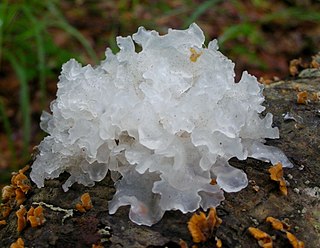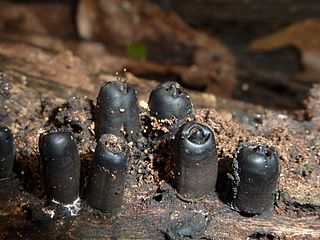
Tremella fuciformis is a species of fungus; it produces white, frond-like, gelatinous basidiocarps. It is widespread, especially in the tropics, where it can be found on the dead branches of broadleaf trees. This fungus is commercially cultivated and is one of the most popular fungi in the cuisine and medicine of China. T. fuciformis is commonly known as snow fungus, snow ear, silver ear fungus, white jelly mushroom, and white cloud ears.

Miles Joseph Berkeley was an English cryptogamist and clergyman, and one of the founders of the science of plant pathology. The standard author abbreviation Berk. is used to indicate this person as the author when citing a botanical name.

Nectria is a genus of Ascomycete fungi. They are most often encountered as saprophytes on decaying wood but some species can also occur as parasites of trees, especially fruit trees and a number of other hardwood trees. Some species are significant pests causing diseases such as apple canker, Nectria twig blight, and coral spot in orchards.

Rigidoporus is a genus of fungi in the family Meripilaceae. Many of the species in this genus are plant pathogens. The widespread genus, which contains about forty species, was originally circumscribed by American mycologist William Alphonso Murrill in 1905. The generic name combines the Latin word rigidus ("rigid") with the Ancient Greek word πόρος ("pore").

Fomitopsis is a genus of more than 40 species of bracket fungi in the family Fomitopsidaceae.

Panus conchatus, commonly known as the lilac oysterling, smooth panus, or conch panus, is an inedible species of mushroom that occurs throughout the Northern Hemisphere. Its fruitbodies are characterized by a smooth, lilac- or tan-colored cap, and decurrent gills. The fungus is saprophytic and fruits on the decomposing wood of a wide variety of deciduous and coniferous trees. Despite being a gilled species, phylogenetic analysis has shown it is closely related to the pored species found in the family Polyporaceae.
Broomella is a genus of fungi in the family Sporocadaceae.

Camillea is a genus of fungi in the family Graphostromataceae. Collectively, the 40+ species in the genus have a widespread distribution, but are especially prevalent in tropical areas. Fruit bodies of Camillea species tend to be cylindrical in shape. The genus was originally circumscribed by Swedish mycologist Elias Fries in his 1849 work Summa vegetabilium Scandinaviae.
Leprieuria is a genus of fungi in the family Xylariaceae. This is a monotypic genus, containing the single species Leprieuria bacillum.

Tyromyces is a genus of poroid fungi in the family Polyporaceae. It was circumscribed by mycologist Petter Karsten in 1881. The type species is the widely distributed Tyromyces chioneus, commonly known as the white cheese polypore. The phylogenetic position of Tyromyces within the Polyporales is uncertain, but it appears that it does not belong to the "core polyporoid clade". Tyromyces is polyphyletic as it is currently circumscribed, and has been described as "a dumping place for monomitic white-rot species with thin-walled spores."

Podoserpula is a genus of fungi in the family Amylocorticiaceae. The genus contains six species including the type species, P. pusio, commonly known as the pagoda fungus. Species of the genus Podoserpula produce fruit bodies consisting of up to a dozen caps arranged in overlapping shelves, attached to a central axis. Its unique shape is not known to exist in any other fungi. The genus is known to occur in Australia and New Zealand, Venezuela, Madagascar, and New Caledonia.
Annulohypoxylon archeri is a saprophytic fungus species. It was moved from the genus Hypoxylon into the genus Annulohypoxylon erected in 2005 by Hsieh, Ju and Rogers.

Entoleuca mammata is a species of fungus in the genus Entoleuca. It is responsible for the plant disease hypoxylon canker in hardwood trees such as quaking aspen and other aspens and poplars, Salix myrsinifolia and other willow species, rowan, Sitka alder, birch, apple, oak, and hop-hornbeam.

Peziza domiciliana, commonly known as the domicile cup fungus, is a species of fungus in the genus Peziza, family Pezizaceae. Described by English mycologist Mordecai Cubitt Cooke, the fungus grows on rotten wood, drywall/plasterboard, and plaster in homes, damp cellars, and basements. It is known from Asia, Europe, North America, and Antarctica.

Hypoxylon canker of shade trees is a weak ascomycete fungus that negatively affects growth and can eventually lead to the death of already dying or diseased host trees. There are many different species that affect different trees. For example, Hypoxylon atropunctatum, a common species, is found on oak trees, Hypoxylon tinctor affects sycamore trees, and Hypoxylon mammatum infests aspen trees.

Xylaria longipes, commonly known as dead moll's fingers, is a species of fungus in the family Xylariaceae.

Cerrena zonata is a species of poroid fungus in the genus Cerrena.
Anders Munk was a Danish mycologist. He was an expert of the fungal group colloquially known as the Pyrenomycetes, and best known for his 1957 work "Danish Pyrenomycetes".

Biscogniauxia atropunctata, the hypoxylon canker, is a species of sac fungus in the family Graphostromataceae. Like many other fungi in the genus, it is a plant pathogen; specifically this species can cause Biscogniauxia (Hypoxylon) canker and dieback disease in host trees.














